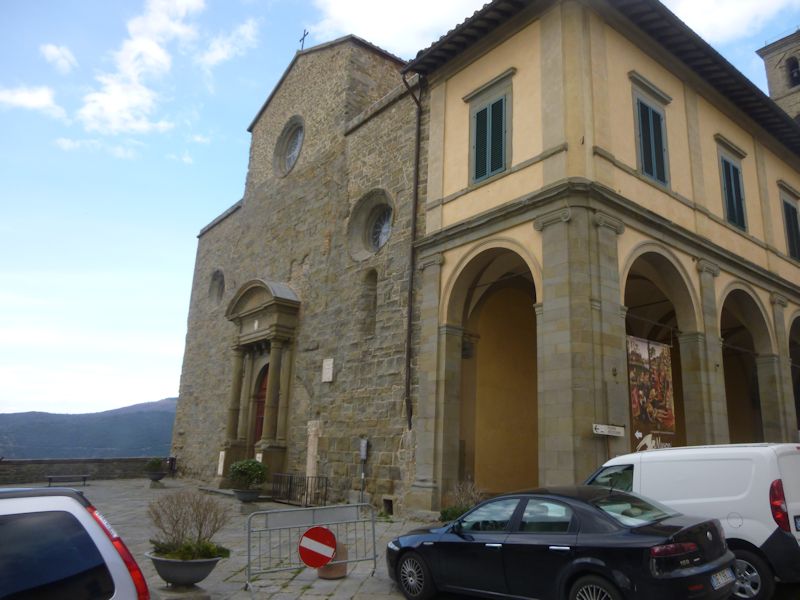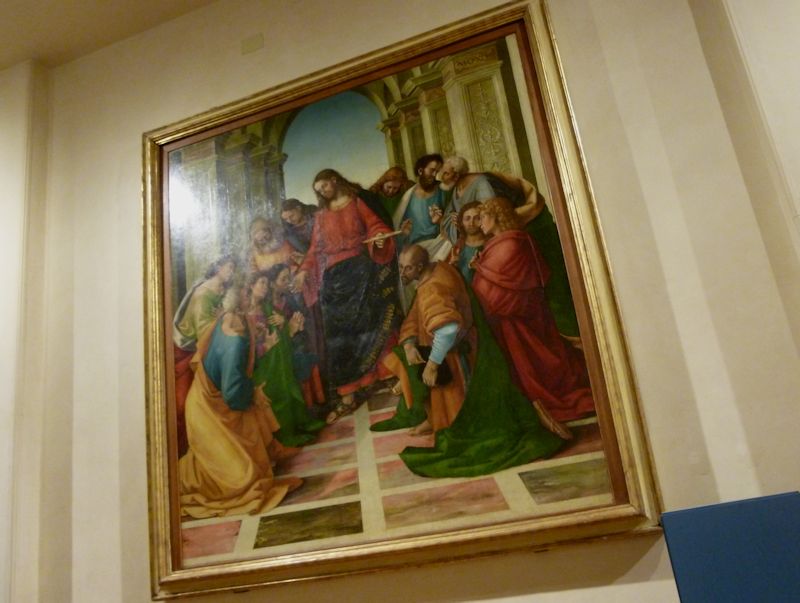|
 Dwight Peck's personal website Dwight Peck's personal website
Tuscany in the off-season
Arezzo and the neighborhood in February and early March, 2015
You may not find this terribly rewarding unless you're included here, so this is a good time for casual and random browsers to turn back before they get too caught up in the sweep and majesty of the proceedings and can't let go.
Arezzo was at the top of our list when we based ourselves in Lucca a few months ago, but we never made it this far south. So here we are now, based in Arezzo this time, with lots to see roundabout.
South of Arezzo: Cortona, Lake Trasimeno (II)

We've been walking round Cortona, the level parts so far, and have wandered by design into the Piazza Duomo.

This is the Duomo di Cortona, formally the Concattedrale di Santa Maria Assunta, called a Co-Cathedral because it shares the seat of the bishopric with the cathedrals of Arezzo and Sansepolcro (since 1986) in one consolidated diocese. The loggia on the right joins the Palazzo Vescovile or Bishop's Palace.

The present Bishop's Palace, over an existing medieval residence, was carried out on the orders of Cardinal Passerini, who became Bishop of Cortona in 1521. The belltower was designed in 1566 by Francesco Laparelli of Cortona, an assistant to Michelangelo who designed the pentagonal bastions of the Castel Sant'Angelo in Rome in 1565 as well; he also talked the Knights Hospitaller into creating a new city of Valletta in Malta to his design after their Fort St Elmo was totally destroyed by Suleiman the Magnificant's Ottoman fleet in the Turks' unsuccessful "Great Siege" of Malta in 1565.

The original church was built very early and then again at least by the 11th century over an old Roman temple, but the present cathedral was in turn built over that in the late 14th century; bits of the earlier church can be seen in the façade. At that time it was not the cathedral, however, despite the fact that from the creation of the diocese in 1325 the bishops were residing in the Palazzo Vescovile next door. In 1507 the Pope sorted things out by transferring the seat of the diocese from the neighborhood church of San Vincenzo down the hill, which no longer exists, to this rather unremarkable edifice.

The main altar dates from the 1660s but much of the rest has been thoroughly remodeled through the 18th century.

The apse end with presbytery, choir, and main altar

Looking back from the presbytery

The relic hoard; all authentic

Out the Cathedral's front door, this is the Diocesan Museum in what was formerly two Jesuit churches from about 1500, remodeled later in the century by Giorgio Vasari.

The Diocesan Museum has a very good collection of religious paintings by Cortonese and Florentine artists, but it's a No Photo Zone and heavily patrolled, so we're mostly going to have to rely on memory, which is pretty useless, and a few sneaky no-flash snaps.

Like this Annunciation altarpiece, by Fra Angelico, from 1433-34

And the Communion of the Apostles, by Luca Signorelli (1512), with Judas hiding his pieces of silver and inviting the viewer not to rat on him.

One of the nine rooms of the Diocesan Museum

A terra cotta deposition scene

The Cimitero della Misericordia below the Duomo, designed in 1883

We're rejoining Kristin at the Teatro Signorelli (1854), which, as of this writing (27 April), is showing
"Avengers: Age of Ultron".

A bracing walk up the hill towards the Church of San Francesco

Just across the street, a once-elegant fixer-upper, presently for sale

Kristin is being unnervingly attentive to the details.


The Chiesa di San Francesco, built in 1245, simple as with most of the churches built by the monastic orders

A single nave with later Baroque altars along the sides. In the convent next door, they've got some relics of St Francis of Assisi (like a pillow), and Luca Signorelli's own tomb is here in the inaccessible crypt. But the main relic-related claim to fame is a piece of the True Cross, donated by Fr Elia Coppi (a.k.a. 'Brother Elias'), a friend of St Francis' and minister general of the order in the 1230s, and an important diplomat in the service of Emperor Frederick II 'Stupor Mundi'. The relic was supposedly given to him when on mission in Byzantium by the Latin Eastern Emperor Baldwin II.

Observing the visitors to the Franciscan church, a cat

The only thing Kristin loves more than a cat . . .

. . . is two cats.

Onward and, mainly, upward


The view from a terrace in front of the Monasterio de S. Chiara: Lake Trasimeno, and just behind the end of the little hill in front of it, the site of the Battle of Lake Trasimene on 21 June 217 BC, when Hannibal's Carthaginians totally destroyed the Roman army of 30,000 legionaries in what has been called 'the largest ambush in military history'.

We've just time for a mad scramble farther up the hill, for a few more churches and the expansive views. Kristin's doing some route-finding back down through the vertical suburbs to the car.

The rustic-style Chiesa di San Cristoforo near the top of the city, consecrated in 1192 with later transformations.

The gate of Porta Montanina at the top of the town, with ruins of the Etruscan city walls and a Roman aqueduct

Back down, this time by the Via San Niccolò

The 15th century Chiesa di San Niccolò with a pleasant porch in front of it. There's not much to say about this one; we're photographing it with the camera stuck through the bars of a padlocked iron gate.

Back down through town, scurrying to catch up with Kristin, who's got the car keys. Farther out along the top of the city is (allegedly) a vast park with the Sanctuary of St Margherita and the 16th century Florentine Fortezza di Girifalco (Falcon Fortress) or Fortezza Medicea, now an exhibition centre amongst other public spirited uses; we didn't get that far along.

Scurrying down, and more down, ouch; ouch.

Down the Via Berrettini, and hurtling past the Casa Pietro Berrettini, the birthplace of the then-well known Baroque painter of the 17th century, also known as Pietro da Cortona.

The former Church of Sant'Antonio Abate, dating from about 1300 but now deconsecrated. The neighborhood here is the site of the 'Bagno di Bacco' or Bacchus' Bath, a huge Roman cistern for distribution of fresh aqueduct water downhill through the city.

In the courtyard of the Sant'Antonio former church

Down from the Sant'Antonio church, and . . .

. . . down some more; ouch.

Back to the Piazza della Repubblica at last (the level street!)

Traffic on the Via Nazionale
Lago Trasimeno

With what's left of the day, we've continued southward into the Province of Perugia in Umbria, past Hannibal's monster ambush of the entire Roman army, to the shores of Lake Trasimeno, and the only sizable town on the lake, Castiglione del Lago.

Lago Trasimeno, an endorrheic lake (no significant outflow) that is nevertheless said to be remarkably clean, perhaps because of the absence of farm runoff in the region, is about 12km across, the fourth largest lake in Italy by surface area after Garda, Maggiore, and Como in that order.

It looks like its surface area is larger now than it has been, because it's out of its banks.

Local flooding. There are presently three islands in the lake, two tiny ones along the northern shore and a slightly bigger one in the southeast, but it's widely thought that the upper town of Castiglione on the western side was once a fourth island whose separation from the shoreline was either infilled by the Romans or paved over by centuries of piazzas, palaces, churches, supermarkets, go-kart courses, and what not.

Kristin on Lake Trasimeno

An inquisitive passerby

Waiting for the ferry

From the carpark near the shore, the Lion Fortress of Emperor Frederick II 'Stupor Mundi', completed in 1247, just three years before his death, under the direction of Brother Elias of Cortona.

It's late in the day, but we'll go up into the Centro Storico and scope the place out.

The Castiglione itself, closed for the day. And the moon.

The main street, from the porch in front of the Palazzo della Corgna or town hall near the fortress. It's agreed now -- this is too good: we're coming back tomorrow.

On the drive back up the state road to Arezzo, we're 'on the run'. Whatever that means.
        
      

 Feedback
and suggestions are welcome if positive, resented if negative, Feedback
and suggestions are welcome if positive, resented if negative,  .
All rights reserved, all wrongs avenged. Posted 27 April 2015. .
All rights reserved, all wrongs avenged. Posted 27 April 2015.
|
 Dwight Peck's personal website
Dwight Peck's personal website




































































